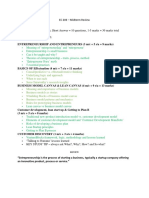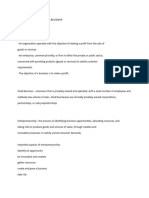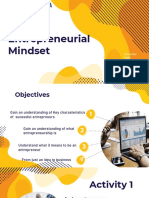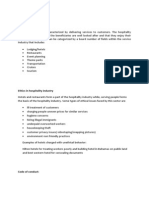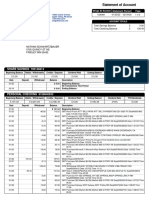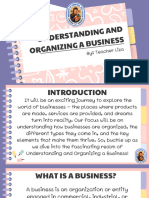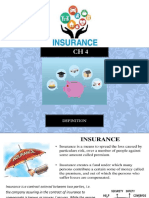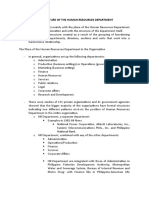21/05/2024
Learning outcomes
After completing this chapter, learners can:
Chapter 7 1. Understand the concept of entrepreneurship and entrepreneurial
spirit.
The Entrepreneurial 2. Understanding and analyzing factors for successful startups.
Mindset 3. Grasp the business startup process and some startup models.
4. Apply creative thinking and self-knowledge to be able to challenge
the entrepreneurial spirit and start-up spirit
7.1 Entrepreneurship - Definition
Contents
• Entrepreneurship is the attempt to create value through recognition
7.1. Entrepreneurship and entrepreneurial spirit. of business opportunity, the management of risk taking, and
through the communicative and management skills to mobilize
7.2 Factors for a successful start-up. human, financial, and material resources necessary to bring a
project to fruition.”
7.3 Basic steps for starting a business.
• Entrepreneurship can be understood as an individual or a group of
7.4 Startup model people starting to build their own business model. This is the
process of creating and growing a new business.
• Entrepreneurs connect their creative ideas with the purposeful
action and structure of a business.
Copyright © 2016 Pearson Education, Inc. 3-4
7.1 Entrepreneurship - Definition Function of Entrepreneurship
• Entrepreneurship is the process of starting & operating your own
business.
• People who create, launch, organize, and manage a new business and
take the risk of the business are entrepreneurs
- Henry Ford introduced the mass production of vehicles by making
them affordable to average people.
- William Hewlett & David Packard started a small business in
Packard’s garage
+ They invented floppy disks & the first pocket calculator.
1
� 21/05/2024
Importance of Entrepreneurship What is an Entrepreneurial Mindset?
- An entrepreneurial mindset is
a set of beliefs, knowledge, and
thought processes that equips
people to recognize opportunities,
take initiative, and succeed in
diverse settings.
- An entrepreneurial mindset as
the set of attitudes, skills and
behaviors that entrepreneurs need
to succeed personally and
professionally.
Who is Entrepreneur?
Entrepreneur is a person who
tries to do something new,
visualizes a business opportunity,
organizes the necessary resources
for setting up the business and
bears the risk involved.
7.2. Factors for a successful start-up Strategic planning ability
• Strategic planning ability
• Having broad visionary.
• Creativity and seizing opportunities
• Knowing how to clearly define mission, vision and have strategic
• Preparation of resources for start-up
thinking
• Related knowledge.
• Planning for the next 3 - 5 years with detailed business plans.
• Ability to research the market and choose business strategies
• Needed skills: time management, emotional management,
• Comfortable with failure and perseverance communication skills...
2
� 21/05/2024
Creativity and seizing opportunities Preparation of resources for start-up
• Identifying unsatisfied needs.
• Creating a difference between your business and the competition, a • Evaluate whether there are enough resources to
difference in products and services launch the business.
• Identifying new markets, new business ideas and choosing new • Resources include financial and non-financial.
business models.
profitable timely
opportunities
stable Value proposition
Important knowledge Market research capability and developing
business strategy
- Necessary business knowledge: market research, competitors, customers, - Analyze the business environment to determine
suppliers, products, prices, promotions... business strategies for startup goals.
- Management knowledge: law, human resources, finance, operations - Market trends, attractiveness, competition
level, growth rate, sales trends
- Specialized knowledge: construction, fashion, cars, etc.
- Competitor research.
- Selecting target market and product positioning
Comfortable with failure and perseverance Group assignment
• Failure is not a hopeless thing. Failure is a lesson to find a better • Identify a business opportunity (What product? Target customers?
business strategy. Which area?)
• In the process of starting a business, not everyone is successful the • Identify and describe some competitors
first time. There are people who fail many times but they still do not
give up and continue to stand up to implement their ideas. • Use the specialized knowledge about the product to decided what you
should do to differentiate your product.
3
� 21/05/2024
7.3 Entrepreneurial Process 7.3 Entrepreneurial Process
• Discovery: An entrepreneurial process begins with the idea generation,
wherein the entrepreneur identifies and evaluates the business
1) Identify/Evaluate Opportunity opportunities.
• Developing a Business Plan: Once the opportunity is identified, an
2) Develop Business Plan entrepreneur needs to create a comprehensive business plan.
• Resourcing: the entrepreneur identifies the sources from where the
3) Determine Resources Required finance and the human resource can be arranged.
• Managing the company: Once the funds are raised and the employees are
4) Manage The Enterprise hired, the next step is to initiate the business operations to achieve the set
goals.
5) Harvesting • Harvesting: The final step in the entrepreneurial process is harvesting
wherein, an entrepreneur decides on the future prospects of the business,
i.e. its growth and development.
McGraw-Hill © 2004 The McGraw-Hill Companies, Inc. All rights reserved.
7.4 Entrepreneurial model General Categories of Business Models
Standard Business Models Disruptive Business Models
• Manufacturer business model • Online sales and multi-level
marketing models
• Retail business model • Dell allows customers to optionally
Startup Business model Implementing configure computers and buy
business idea and strategy strategy • Franchise business model remotely
• Service business model: • Google provides online advertising
services,…
advertising, education, health
care • Grab provides technology taxi
booking services,…
Business model canvas: Lean startup model
Business model canvas: Lean startup model How does it work?
What is the Business Model Canvas?
• The Business Model Canvas is a visual representation of the 9 key
building blocks that form the foundations of every successful business.
It’s a blueprint to help entrepreneurs invent, design, and build models
with a more systematic approach.
• Its useful for start-ups to identify what they need going forward and
for the annual planning of initiatives at company or department level.
4
� 21/05/2024
Business model canvas: Lean startup model Business model canvas: Lean startup model
How does it work? How does it work?
Business model canvas: Lean startup model
Business model canvas: Lean startup model How does it work?
How does it work?
• 4. Revenue Streams – How will you make money? Revenue streams result
1. Customer Segments – Who is your customer? Identify who would from value propositions successfully offered to customers. Will you whole
be your key customers and group them by their pain points, sell? Will you have an e-commerce website? Will you have a brick &
demographics, buyer behavior, or other relevant characteristics. mortar store? Will you have add-on services? In other words, explain what
your primary, secondary, and additional revenue sources will be.
2. Value Propositions – What makes you better than others? It seeks to • 5. Customer Relationships - How will you interact with your customers?
solve customer problems and satisfy customer needs with value Think about your sales process starting from the initial step. If you are
propositions. selling online, your leads would start searching online, then they would go
to your website to find more information.
3. Channels – How will you communicate your value proposition?
What are your marketing tools? Some answers might be social • 6. Key Activities – What are the activities that would enable you to deliver
media (but be specific, which social channels?), paid advertising, your value proposition? Let’s go back to your value proposition and think
distribution channels, print advertising, etc. about our coffee shop example. You identified a few criteria, freshness,
speed, and quality, that you think you can do a better job than your
competitors.
Business model canvas: Lean startup model Business model canvas: example - Uber
How does it work?
• 7. Key Resources – Who/what are your key resources? Anything that
you own that would help your business become successful is your key
resource.
• 8. Key Partners: You need advisors, mentors, supporting
organizations, a chamber of commerce, a lawyer, and an accountant.
• 9. Cost Structure: What about your fixed costs and variable costs?
What are your major costs? R&D, capital expenditures, and cost of
goods sold.
5
� 21/05/2024
Business Model Canvas Example – MoviePass Business model canvas: example - Facebook
Barringer/Ireland Business Model Template
Barringer/Ireland Business Model Template
1. CORE STRATEGY 2. RESOURCES
- Although not everyone agrees precisely on the components of a Core competencies Key Assets
business model, many agree that a successful business model has a Mission Differentiation
common set of attributes.
- These attributes can be laid out in a visual framework or template so it Target market
Product/market
is easy to see the individual parts and their interrelationships. scope
- The Barringer/Ireland Business Model Template is shown in the next 3. FINANCE 4. OPERATION
slide Revenue Streams Channels
Product (service)
Production
Financing Funding Cost structures Key Partners
Lean Business Model: Things to takeaways Trends in Entrepreneurship
• Start by outlining a short list of key elements to guide your
business and update as needed. • Availability of technology
• The plan focuses on the core business so only important
details about marketing, revenue, and finance are • Increased global communication
included,… • Rise of the Internet and e-commerce
• Rules:
1. Make it short and simple • Increasingly diversified society & market
2. Test the minimum viable product
3. Review the results
4. Modifying or adjustment
6
� 21/05/2024
Vietnam – FPT: Case 1
• Who started FPT?
- How?
- Why?
• What was FPT’s original business?
- Were they successful in this business?
- How did FPT’s business evolve over time?
- Are they successful? Why or why not?
Application
Case 2:
• Identify an opportunity of business
• Apply business model Canvas to develop your business
strategy.
Case 3:
• Apply business model Canvas to analyze business strategy of
an enterprise that you wish to.
7
� 21/05/2024
Business model canvas: example - Netflix




























